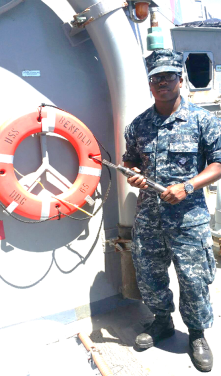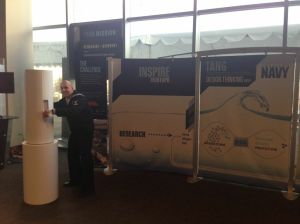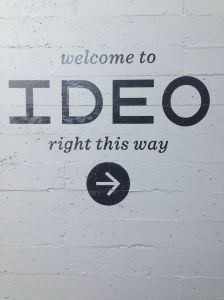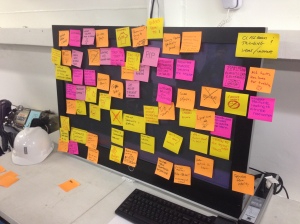By: LTJG Tom Baker

On the afternoon of Monday June 8th, I left the mighty BENFOLD and drove north to Marine Corps Air Station Miramar, excited about a promising opportunity to collaborate, create, and solve.
It was a slow roll through the front gate – ID check sat – and after two wrong turns in an unfamiliar base, I found my way to the Miramar Officer’s Club. With slightly wrinkled slacks and polo shirt from my journey, I entered to find two brightly smiling faces at a table full of gizmos and documents. “Hi, welcome to 3M TANG!”.
I was christened with my colorful badge, complete with a “Mavericks” team button. Thoughts filled my head like, ‘what is this thing for!?’ and ‘What have I gotten myself into?’
Oh was I in for a surprise.
I was gestured to the right into a large room and what fell before my eyes was what an innovator at heart may compare to the large candy room that Willy Wonka reveals to the children during their factory tour. And so my voyage into wonderful world of TANG began.
This is 3M TANG – in detail: The Maintenance, Material, and Management (3M) Tactical Advancements for the Next Generation. From June 8th-11th, 30 hand-selected warfighters were chosen to help create ideas, concepts, and solutions for future 3M systems, displays, hardware, policy, and procedures. This three-day workshop that I was attending – the culmination of months of research and insight generation – was designed to make tangible improvement to what the Navy largely affirms to be an outdated and broken maintenance system.
The first TANG event was held in 2011 to address challenges associated with Submarine displays. ADM Richardson, then the Commander of Submarine Forces, called for positive change and away the first TANG went – in San Diego – to prototype some concepts. The teams, through iteration, went from foamcore prototypes at the event to working models within a handful of months, finally transitioning concepts onto Submarines through the APB process. Since that first event, the team has accomplished several TANGs tackling a variety of challenges – Executive TANG, Australian/US TANG and Surface ASW TANG just to name a few.

3M TANG – the most recent event for the team – and plenty more to come!
TANG has been relentlessly successful because their creative structures accomplish two otherwise rare practices. One, they place stakeholders, technology experts, and warfighters in one room. Normally, the creator & stakeholder are geographically separated from the sailor, so valuable lines of communication and feedback are delayed. Secondly, TANG manages to get everyone rowing in a unified direction! Objectives are clarified quickly, and the team keeps each other in check.
Groups of people talking closely, jotting down notes on large white posters, laughing, or gathered around booths holding, wearing, and interacting with some of the coolest tech I’ve ever seen. My nervousness dissipated as I saw familiar faces in the room ~ a family of supporters and creators that have held The Athena Project afloat since its earliest inception, joined together with the TANG team was incredibly welcoming and put me into a state of creative euphoria.
The first event – the Tech Expo – showcased some of the most respected companies standing side-by-side with organizations that I’ve never heard of – their ideas all equally-incredible. I spent the rest of day one playing with technology and interacting with the creators who I realize are wholly devoted to giving our Sailors their best.
The tech expo is geared toward “unlocking the realm of the possible” to inform the brainstorming efforts of the teams from around the fleet. Over the next three days, our teams would engage in the process of Design Thinking to brainstorm, prototype, and present our creations.
I hardly thought that the second day could be better than the first, but I was wrong. The TANG team, partnered with award-winning innovators at IDEO, identified 14 solutions to known 3M issues that emerged throughout the course of some exhaustive empathetic research around our fleet. So, one of the first primers we did was to provide feedback on those concepts. Through “I wish” and “I like” statements, along with questions and concerns, the room collectively penned sticky notes to accompany these concepts, an exercise designed to kick-start the brainstorming process.
After we finished the concept card exercise, I came to find out that the “Mavericks” button I’m wearing is a team name. And, after a rousing and supportive speech by the Commander of Naval Surface Forces, Vice Admiral Rowden, the room is fired up to create!

We kick off the Design Thinking Process with some brainstorming. The goals are to generate a lot of ideas in a little time, get different perspectives, and build some excitement! Each group member starts slapping sticky notes to these ideas with every thought under the sun. I noticed a little poster next to our white space.
THE 7 RULES OF EFFECTIVE BRAINSTORMING
- Defer judgement
- Encourage wild ideas
- Build on the ideas of others
- Stay focused on the topic
- One conversation at a time
- Be visual
- Go for quantity
Some of the notes are features: “WIFI”, “Bluetooth”, “PERSONAL Profiles!”. Other stickies are more conceptual, or the “how” behind other stickies: “Hire coders”, “Partner with existing tablet creators”. Some of our mates are categorizing and connecting ideas as we go along. Everything is so fluid. During this process, I start learning how each of my new friends thinks. Those stickies and the conversations about them start to reveal personalities, and we fall naturally into our team roles.
Our mission, together, was to combine a couple of really interesting ideas that the team had collectively brainstormed and voted on. The PMS Recipe Card is a platform and ship specific set of digital maintenance instructions. PMS is planned similar to meal planning as it captures what tools, qualifications, hazardous materials, and training are necessary to carry out the plan. Our other idea, the Workcenter 3M Tablet, provides the ability to take these PMS Recipe cards anywhere in the ship, and even write and submit a job or feedback report.
Once we had the direction for our new concept, we dive into the room’s ‘arts and crafts’ section to get our ideas into the physical space. There were tables filled with large white papers, foamcore, glue guns and a table full of a crazy conglomerate of supplies (pipe cleaners, whiteboard markers, full-size candy bars… you get the idea).

Team Mavericks – having fun with Top Gun puns since 2015.
Our team is now deep into prototyping. There is no better way to communicate a concept to our team with minimal investment. We can tear it apart, tweak it, or add on to it as soon as we see the need. I see some more guidance on the wall for this step in the process. Luckily I had some notes from a quick brainstorming and prototyping presentation by Dave Blakely from mach49 to remember the details:
PROTOTYPING
- Building to think. Prototypes are tools used both to validate ideas and to help us generate them. Prototypes force us to think about how someone would interact with our concept.
- Rough & rapid. Prototypes are exploratory, not precious. They should be built as quickly and cheaply as possible.
- Answering questions. It’s essential to know what question a prototype is being used to answer: whether it’s around desirability, usefulness, usability, viability, or feasibility.

The prototyping toolbox.
I drag a piece of foamcore the size of a picnic table over to our corner of the room. My friends are at the table of supplies, gathering markers, scissors, more stickies (because we understand the need at this point), and even manage to return with a handful of chocolate chip cookies. We are really clicking at this point. We cut out a foam-core tablet larger than the bed of a full-size pickup truck. There are so many concepts to visualize that we start drawing out “screen shots” on large pieces of white paper. With some help from the TANG facilitators, we realize we can rotate these white papers through our tablet frame to visualize to an audience.
Some of us want to add more detail, others realize the tight timeline we are on and move quickly to the next screen. Again, our personalities revealed, roles refined. We met each other 40 minutes ago and operate like a well-oiled machine.
Eventually, we would present our prototypes and concepts to the entire TANG audience and receive the invaluable live feedback through “I like” and “I wish” statements, questions, and concerns. Earlier in the writing I spoke about the three teams of warfighters. Well, there’s a fourth team of Stakeholders – the technology holder, sponsoring companies and those who want to and CAN create positive change – who will be giving feedback on our ideas and also sharing their own ideas to positively impact the future of 3M in the fleet. Our prototyping and presentation processes start to reveal who they are.
Another half hour later, and the room comes alive in theatrics as we rehearse our presentation. We feel confident about our prototype. It’s time to receive feedback and refine! At this point I recall my mind being expanded yet exhausted. I was fulfilled by the roller coaster of turning a collection of several hundred thoughts into something I could hold in my hand, complete with a rehearsed delivery by a cohesive team. And the most exciting part of this design thinking process, was that all of this preparation is to create something intentionally non-permanent – ready for alteration, destruction, further creation, all by design. It’s easy to iterate on something that’s a rough prototype – much easier than when we’ve already dumped millions of dollars into a solution BEFORE gaining the warfighter feedback. The tendency is to NOT change things then. I walked away from the event excited about the fluidity and fragility of our idea’s future.
When we finished our sharing session, with all the teams presenting their ideas to the crowd, the room was filled with an incredible energy. It was a good thing, too: Because we were about to do the whole process one more time!
I took with me the incredible lessons in a new approach to problem-solving. It brought me back to my undergraduate days when I had read about these processes occurring at IDEO and other forward-leaners. Being immersed in Design Thinking revitalized my sense of confidence in our ability to solve large and small scale challenges. I am passionately drawn to thinking about our underlying purpose at The Athena Project. This experience was a “how” that I believe our incredibly talented Sailors can and should be encouraged to utilize when approaching an increasingly dynamic set of challenges and future threats.
We can set our focus primarily toward innovations, solutions, and products, and I believe we will enjoy a few breakthroughs. OR, we can set our focus toward changing the way we think and approach our environment, and I believe we will enjoy both a culture of dynamic problem-solvers, AND a far greater byproduct of innovations, solutions, and products!
LTJG Tom Baker is the First Lieutenant and Public Affairs Officer onboard USS BENFOLD and the San Diego lead for The Athena Project. He’s a proud graduate of Oregon State University, earning his degree in Entrepreneurship.
Stay tuned for our official announcement of Waterfront Athena 8! If you’re in the Pacific Northwest and want to participate, reach out to the Athena team on Facebook, Twitter or e-mail!
Connect with The Athena Project on Facebook: www.facebook.com/athenanavy or follow us on Twitter: @AthenaNavy. Interested in starting a movement of your own? Message us, or e-mail athenanavy@gmail.com!


























